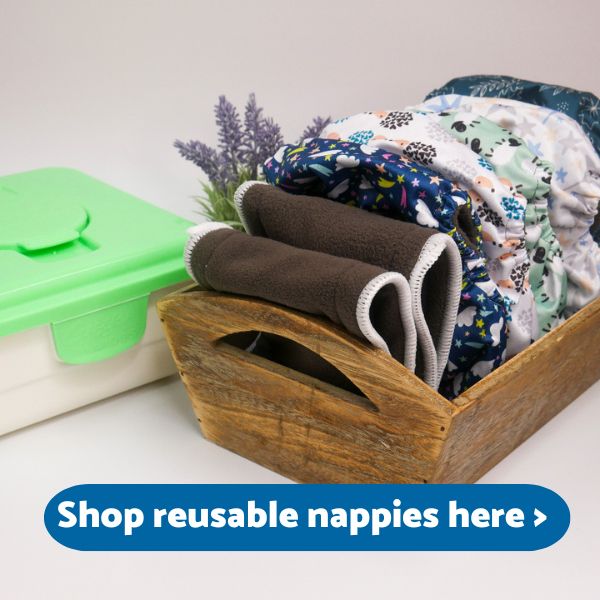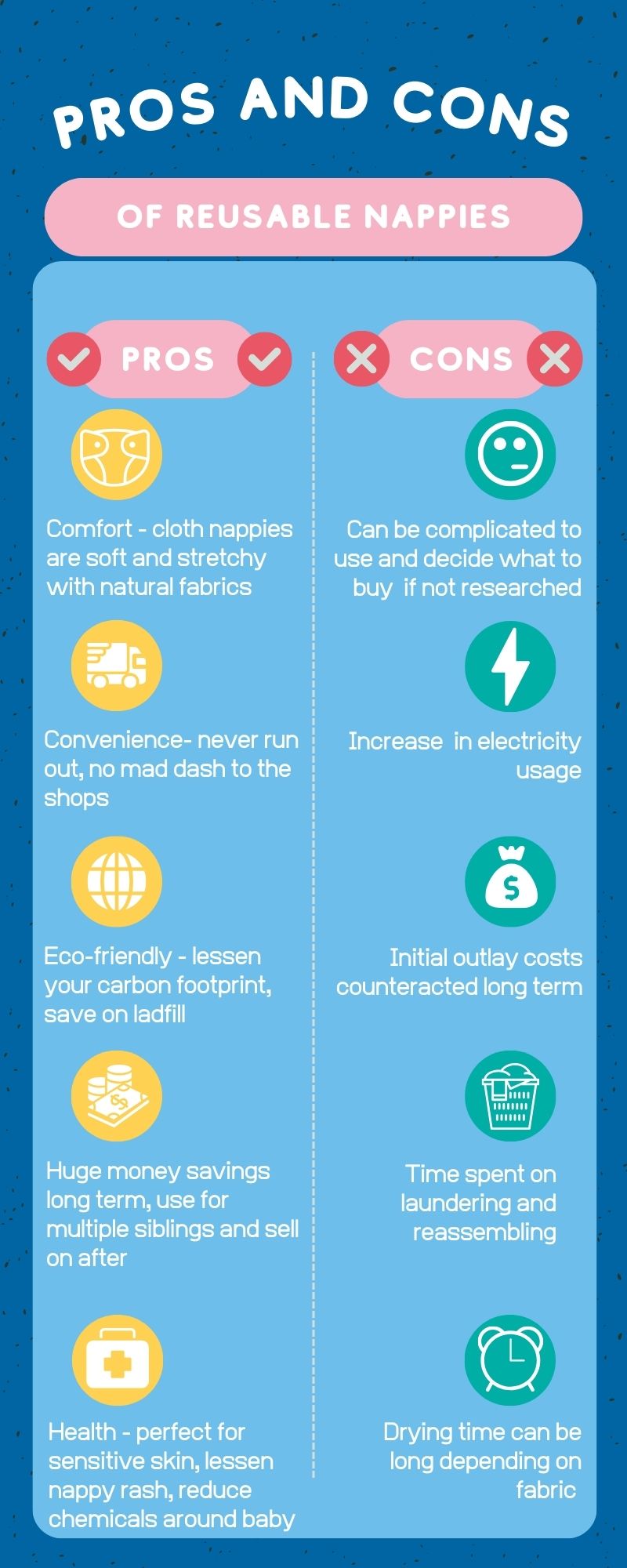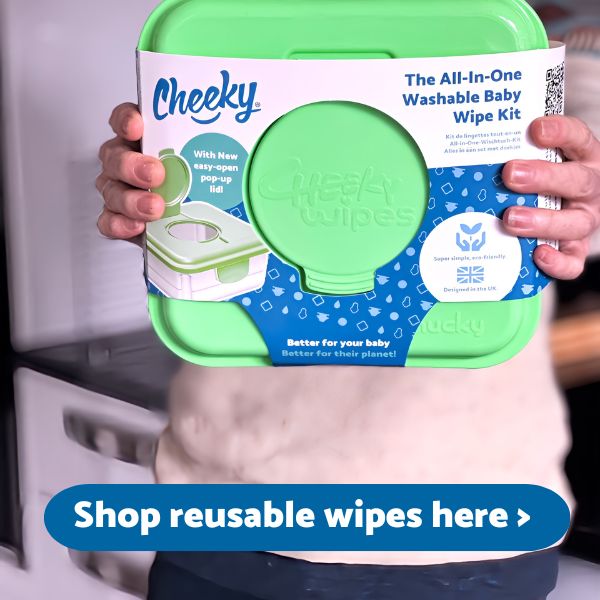Cloth Nappies vs. Disposable Nappies: The Pros and Cons18 April 2024 Having a baby opens a whole new world of decisions - to baby wear or buy a buggy ... or both! Purees or baby led weaning ..... or a bit of both! Co-sleep or have baby in their own cot .... I can promise you it will be a bit of both! One big decision will be which nappies to use. Will you go for cloth nappies or disposable nappies, or a bit of both? Both options have their advantages and drawbacks, and understanding them can help you as a new parent make an informed choice. My youngest (now thirteen) wore reusable cloth nappies, I loved them and found they fit into my lifestyle well even though I had five year old twins too. I would recommend you explore cloth and keep in mind it doesn't have to be an 'all or nothing' full time approach. One cloth nappy a day keeps 365 single use diapers out of landfill each year. As with other baby items why not aim for a mix of both! Read on for a comparison of the pros and cons of cloth nappies vs disposable nappies: - Comfort
- Convenience
- Ease of use
- Carbon footprint
- Cost
- Health
- Comfort
- Convenience
- Ease of use
- Carbon footprint
- Cost
- Health
Cloth nappies have moved on from the terry towelling sheets our Grannies boiled on the stove and rubbery plastic pants. The principles are the same, you need absorbent layers of material with a waterproof layer on top. There are many different types of cloth nappies come in adorable designs from dinosaurs to floral prints and everything in between, I've even had a Hungry Caterpillar nappy! 
Cloth nappies are more comfortable than wearing highly absorbent plastic layers. Made from soft, natural fabrics like cotton or bamboo, they are gentle on sensitive skin and reduce the risk of nappy rash. You may find you need to size up in baby clothes to fit the extra bum size in. Make sure that onesies press studs don't compress the nappy or you will get leaks. Modern cloth nappies demand more effort with washing and drying routines, but advancements in design and accessories have made them more user-friendly than ever before. An advantage of cloth over disposable nappies is that with a good wash routine and a good size stash, you will never run out. Cloth nappies, while not as straightforward as single use nappies, have become easier to manage with modern types of nappy such as all-in-one systems or pocket nappies. They do require regular washing and line drying, which adds an extra step to the routine. Cloth nappies can be tricky to fit, leading to leaks. Research, along with trial and error are the best approach - expect there to be a learning curve. Once you are fitting nappies well and your absorbency matches babies output, cloth nappies are bomb proof with none of the poonamis experienced with disposable diapers. Washable nappies are far better for the environment than single use nappies. You wash and reuse cloth diapers rather than throwing them in the bin. Opting for reusable nappies and reusable wipes is more eco friendly and can halve a families household waste, no need for plastic nappy sacks too. You will increase your wash loads so you may use more electricity personally, however disposable nappies use much more electricity to make which will be past on to you in the price, and is an additional cost for the planet and the climate crisis. Limit the increase in electricity use by bulking out the nappy wash with babies other clothes, towels and bed sheets. Just begin by rinsing the nappies alone in the machine, getting rid of most of the waste before adding to it. 
Initially, costs of cloth nappies may seem more expensive due to the upfront investment and the ongoing costs of washing. Over time, they prove to be more cost-effective, especially if reused for multiple children. After toilet training washable nappies can be saved for future babies then sold on. If you buy preloved nappies at the start you will keep your costs down even more. - Time - Whilst you need to wash, dry and stuff reusable nappies, you save time as you don't run out saving trips to the supermarket
- Money - There will be an initial outlay but by choosing one size or birth to potty nappies that grow with your baby you won't need to keep adding to your stash
- Resources - If you are concerned about cloth using too much electricity or space in your changing bag opt for two parters where the outer shell can be reused over many nappy changes, just switch the inner fabric layers
Cloth nappies are considered healthier for babies due to their natural materials and reduced exposure to chemicals. They allow for better airflow, which can help prevent diaper rash and other skin irritations. It is important that cloth nappies are thoroughly clean and sanitary. Always strip wash second hand nappies, and after an infection or stomach bug. Modern detergents and bio washing powder can clean them effectively. 
"Doodoo nappies and wipes = game changer! I love this company and such a fan of their products. I use the cheeky wipes and doodoo nappies for my baby. The wipes are much better than disposable wipes as I can clean my baby using just one wipe whereas disposable water wipes I would use perhaps 3 or 4. I also find that my baby’s skin has improved. The nappies fit really well on my baby. Are not bulky and I think my baby can more freely when compared to other brands I have tried such as little love bum and bambino mio and they do not leak. I was initially worried that I have to put the cloth nappy on and then the wrap rather than just one nappy like the other brands but it doesn’t effect me at all and the nappy is a much better fit. The longest I had the nappy on was for an over night of 7 hours of uninterrupted sleep and there was no leaking! The customer service is amazing, I have used both the live chat and email when I had some queries before I made my purchase with the nappies. I now wouldn’t shop anywhere else for my reusables now and 100% recommended this company." Jan '24 Trustpilot Disposable nappies are designed to be convenient, are thrown away after use, and they come in various sizes to fit babies of different ages and weights. They are made of a combination of synthetic materials such as polyethylene, polypropylene, and super absorbent gel materials like sodium polyacrylate, which can hold a significant amount of liquid. The chemicals and synthetic materials in disposable nappies can cause irritation for some babies. Sitting in paper and plastic isn't ideal and when swollen they can be heavy and dangle between the legs inhibiting movement. There are more environmentally friendly / organic disposables but they are expensive. Disposable nappies win the convenience race, hands down. They are easy to use, requiring no washing or drying, making them ideal for busy parents or when travelling. BUT they do end up in your kitchen bin, normally inside the additional waste of a nappy sack - and they stink, I used to end up with the bin out on the driveway! Flushing poo from a reusable and keeping in an airy storage system is smell free. Disposable nappies offer unparalleled ease of use. Simply put them on and throw them away when they're soiled. They can be frustrating if you accidentally rip the wing tab off, making it unusable. Sposies are notoriously poor at containing newborns liquid poo, it often shoots out the top of the nappy ending up at babies neck. There is no deeper horror than trying to wriggle babies clothes off without smearing their faces and hair in it! This doesn't happen in cloth with nappy liners. Even the most hardy cloth bum parents sometimes turn to disposables for ease of use. If you have a tummy bug in the house, if you are going on holiday or suffer a washing machine failure there is no pressure to keep going with your cloth. When it comes to environmental impact, cloth nappies take the lead, they generate significantly less waste compared to disposable nappies, which can take hundreds of years to decompose in landfills. Cloth nappies offer the option of organic materials and can be reused for multiple children, further reducing their carbon footprint. Disposable nappies, although cheaper upfront, incur ongoing expenses that accumulate over time, making them more expensive in the long run. - time - They run out, you go through at least 10 a day, kids grow out of them leaving you with packs wasted if you try and bulk buy
- money - You will be buying them for at least 2 if not 3 years, the bigger the nappy the less in a pack and the more expensive, the kinder to the skin
- resources - There is no question that they are bad for the environment and with the addition of disposable wipes and nappy sacks your outlay is considerable
Disposable nappies (and disposable wipes), while convenient, may contain chemicals such as dioxins or fragrance additives that can potentially cause health issues in some babies. Choosing cloth wipes helps to keep chemicals off babies skin too, and are far more environmentally friendly. They compliment cloth nappies but can easily be used alongside disposables too. 
The choice between cloth and disposable nappies ultimately depends on individual preferences and priorities. While disposable nappies offer unmatched convenience, cloth nappies excel in comfort, environmental sustainability, and long-term cost savings. By weighing the pros and cons of each option, you can make an informed decision that best suits your family's needs and values. I got on well always using a mix of both. If this article was helpful, have a read - Beginners guide to reusable nappies Best Cloth nappies in Australia 2024 How many reusable nappies do I need? Sanitising cloth nappies If you're unsure of what you need to make the switch, please do drop the team a line or use the online chat function. The team all use the products themselves and just LOVE to chat pee poo and periods, all day long, nothing is TMI and we all love to overshare based on our own experiences. About the Author: Kirstin is part of the Customer Experience team at Cheeky Wipes, which since 2008 has been selling the original reusable wipes kit. She is mum to three kids and loves the forest, the sea and the hills! Along with the rest of our crack team, she spends most days talking about poo, pee and periods and loves a chance to overshare. Cheeky wipes were recognised with a Queens Award for Enterprise in Sustainable Development in 2021, celebrating their hard work over the last 13 years. |